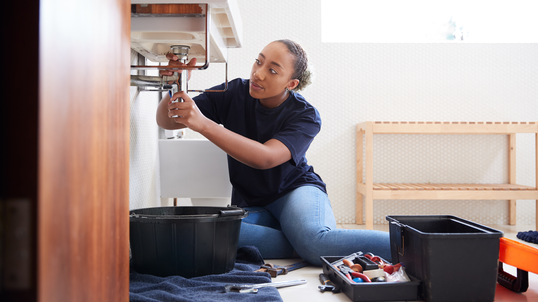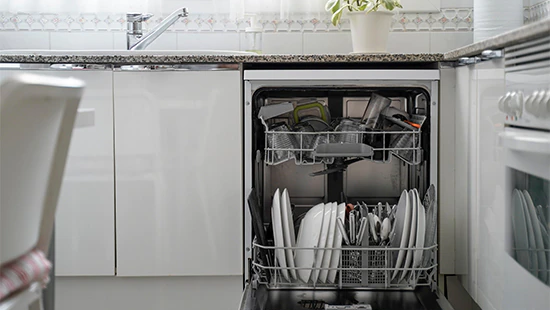9 Ways to Avoid Laundry Room Water Damage

(DESCRIPTION)
The red umbrella in the Travelers logo shades the S in Travelers. Text, Preventing a Washing Machine Disaster. Laundry tumbles in an animated washing machine. A yellow warning symbol with an exclamation point appears inside.
(SPEECH)
[AUDIO LOGO]
[MUSIC PLAYING]
SPEAKER: It's hard to think that something as ordinary as doing laundry could pose a significant risk to your home. But if something were to go wrong with your washing machine, it could flood gallons of water onto your floor in minutes.
(DESCRIPTION)
Soapy water leaks from the bottom of the washing machine. Nearby, sudsy water cascades down a staircase.
(SPEECH)
Here are four simple steps you can take to help prevent a washing machine disaster.
(DESCRIPTION)
A checklist reads, Preventing a Washing Machine Disaster. It has four items, represented by lines with checked boxes next to them.
(SPEECH)
One, only operate your washing machine when you're home so you can catch a leak quickly if it occurs.
(DESCRIPTION)
The washing machine runs. Outside, a car leaves the home's garage. A crossed-out symbol appears over the departing car. In the laundry room, a disk-shaped sensor on the floor emits a red signal when water from the machine reaches it.
(SPEECH)
Consider placing a water sensor by your machine to be alerted of a leak even faster. Two, find the shut off valve to your washing machine and turn it off when the machine is not in use. If you don't have a shut off valve, consider having a plumber install one.
(DESCRIPTION)
Above the washing machine, two valves, a red one and a blue one, sit to either side of a pipe in the wall. The tops of the valves rotate from right to left, shutting off.
(SPEECH)
Three, visually inspect the hosing and plumbing connections for signs of wear, corrosion, or breaks.
(DESCRIPTION)
The blue and red valves have blue and red hoses that connect to the upper back of the machine. The gray hose between them connect to the lower right on the back of the machine. Icons show hashmarks on a worn pipe, black splotches on a corroded pipe, and a broken pipe connection with red lightning bolts flying.
(SPEECH)
Replace the hoses according to the manufacturer's recommended time interval. Four, make sure the drain line to your washing machine is secure at both ends. If you're not sure how to do this or if you see anything that may look problematic, consult a licensed plumber.
(DESCRIPTION)
The ends of the gray hose flash, at the point where it meets the wall and the point where it meets the machine. A hand lifts a smartphone, showing the contact, Plumbing Professional. The hand hits a green phone icon, and the screen reads, Plumbing Professional. Calling.
(SPEECH)
Talk to your Travelers representative or independent agent today.
(DESCRIPTION)
TRAVELERS. Copyright 2024 This material is provided for informational purposes only. It does not, and it is not intended to, provide legal, technical, or other professional advice, nor does it amend, or otherwise affect, the provisions or coverages of any insurance policy issued by Travelers. Travelers disclaims all warranties whatsoever.
Travelers and the Travelers Umbrella logo are registered trademarks of The Travelers Indemnity Company in the U.S. and other countries. The Travelers Indemnity Company and its property casualty affiliates, One Tower Square, Hartford, CT 06183.
When people think about their favorite rooms in a home, the laundry room probably isn’t what comes to mind. However, while often overlooked, this room helps to keep our lives running day-to-day.
Your laundry room is where you clean your outfit for tomorrow’s interview, your child’s soccer uniform for the game, your everyday attire, vacation clothes and more. It’s also an area that typically contains multiple water fixtures and sources such as a washing machine, sink, pipes, hoses and sometimes a water heater.
Though water is essential to a well-functioning laundry room, it can cause damage if leaks occur. That’s why regular inspections and maintenance are recommended to quickly address any necessary repairs. Otherwise, the water that should be busy freshening up your wardrobe could be spreading across the floor instead.
Causes of laundry room leaks
To help minimize the risks, it’s important to know how each laundry room component can potentially create a water event in your home.
Washing machines
Your washing machine, usually the main source of water leaks in the laundry room, may be vulnerable in multiple ways. Common reasons for washing machine leaks include:
- Overloading.
- Uneven pedestal or flooring where the machine is placed.
- Clogged drain lines.
- Cracked pipes.
- Corroded water supply lines and connectors.
- Faulty valves.
In front and top loading washing machines, water leaks may occur due to overloading the machine and using too much detergent. An unlevelled base can cause an unbalanced machine that shakes while in use and spills water on the floor.
Sinks
Laundry room sinks, as with kitchen and bathroom sinks, may also be sources of leaks. Faucet leaks are generally caused by improper installation or worn-out parts. However, it’s the pipe underneath the sink that’s a source of potentially serious leaks – usually due to a loose connection, corrosion or a clog.
Pipes
Pipes hidden in walls, cabinet spaces and under floorboards may start leaking long before you detect it. You may not know about it until you see damage to walls, flooring or ceilings. A plumber can pinpoint the exact location of hidden pipe leaks.
Water heaters and expansion tanks
Many homes have laundry rooms in basements or have a combined utility room/laundry room. In these instances, a water heater may also be a source of leaks. It’s important to have your water heater’s anode – a long tube in the center of the tank – inspected by a professional. The anode protects the water heater from corrosion. Once it goes bad, corrosion happens quickly.
Water heater expansion tanks should be checked by a professional for potential corrosion as well. Other typical leak culprits include cracked supply hoses and rusted valves.
Types of laundry room water damage
Whether your laundry room is on the first floor, second floor or basement, water incidents may lead to expensive damage. And water-related home insurance claims can easily reach several thousand dollars or more.1 Some types of damages that may occur from laundry room leaks include:
- Light-brown or beige stains on your walls and/or ceiling.
- Bubbling, peeling and flaking paint.
- Swelling, warping and discoloration of wooden wall cabinets.
- Puffy, sagging walls or ceiling.
- Warped floorboards.
- Broken appliances.
- Electrical issues.
- Mold and mildew.2
To get a sense of the destruction a water event in your laundry room can cause, here’s an illustration of how it could play out in your house:
Hear sounds of water in your house? Don’t drift away.
It’s late at night and you hear what sounds like trickling water in your house. You can’t pinpoint where the sound is coming from. It might be the washing machine or the sink in the laundry room down the hall. After a quick check, you can still hear it but can’t see any obvious leak. Since you’re very tired and it doesn’t seem like anything major, you decide not to bother with it right now and go back to sleep. Besides, you figure the plumber won’t be able to look at it until the morning anyway.
Meanwhile, the leak continues to get worse. It forms a pool of water behind your washing machine. The water, from a faulty supply line, has also traveled behind an adjacent wall. Wood flooring and trim, as well as drywall have been damaged, creating conditions for further issues and potentially sizable and costly repairs. Although you originally just wanted to get some sleep, you eventually discover a water damage nightmare.
How to help prevent laundry room water leaks
The best defense against outcomes like the scenario above is to know proactive steps you can take to help prevent laundry room leaks before they happen. And if a leak has already started, you’ll want to understand how to stop it from getting worse.
1. Find your water shutoff valve and know when to use it.
If your washing machine starts to leak or gush water, being able to shut off your house’s water supply quickly can make a critical difference in helping to minimize damage. It also helps to know where the local shutoff to your washing machine is located, which may allow you to stop a leak even faster. If you’re not able to find one or both of these shutoffs, consult with a plumber before a problem occurs. You should also turn off your washing machine’s water supply when it’s not in use, or when you’ll be gone for extend periods.
2. Check hoses, pipes and surrounding areas regularly.
Visually inspect your washing machine supply hoses for signs of wear and tear or damage. Washing machine hoses don’t last forever and have specific expiration dates. Sometimes these dates are printed on the hose itself or on an attached tag. If you’re not sure when your hoses expire, ask a professional. Also check the areas surrounding your pipes, cabinetry or other nearby materials for drips, leaks or damage.
3. Consider connecting your drain pan to a floor drain.
A drain pan sits under your washing machine and helps provide a first line of defense against minor leaks. Drain pans can connect to a drainpipe to help channel excess water out of the pan.
4. Make sure your drain lines are secured.
As water drains from your washing machine, there can be a lot of force applied to your drain line. That force may cause the line to become dislodged from the drainpipe if not properly secured. If you’re not sure how to secure the lines or are unsure if they’re properly secured, reach out to your plumber.
5. Consider adding a leak detector.
A simple way to help minimize damage from leaks is to use a water sensor or smart leak detector. These devices can be placed in your laundry room and are sensitive to moisture – sounding an alarm when moisture is detected. Newer smart models can use your home’s Wi-Fi to send an alert to your phone. Some models may even be integrated into smart home systems that can automatically shut off the water to your home when a leak is detected.
6. Don’t leave your washing machine unattended.
While it’s tempting to turn on your washing machine when you go to bed or step out to do errands, this creates an unnecessary risk of a water disaster. Just as you wouldn’t leave your stove on while you’re away from the house, don’t run your washing machine if you’re not home to monitor it.
7. Keep your utility sink clean.
Many laundry rooms include a utility sink. It can serve as a place for pre-soaking or hand-washing clothes, or as an additional drainage site for your washing machine. Keeping your sink clean and unclogged helps ensure that any overflow goes down the drain and not onto your floors.
8. Mark your washer’s placement.
Pay attention to the position of your washing machine, as it may move during operation. If you notice any movement, check for an imbalance issue and address the problem before supply lines become stressed.
9. Maintain proper ventilation.
Running a vent, or using a dehumidifier, helps control humidity and moisture created in laundry rooms.
Keep your laundry room working for you
Behind the scenes, your laundry room plays a central part in getting you ready to face each day. Give it the attention and maintenance it needs so it keeps working for you, not against you in the form of costly water damage.
To safeguard your home today, get a quote or contact your local independent agent to find coverage that matches your budget and lifestyle.
Sources
1 https://www.iii.org/fact-statistic/facts-statistics-homeowners-and-renters-insurance
2 https://www.inspectionsupport.com/what-you-need-to-know-about-water-damage-before-you-buy-a-home/



